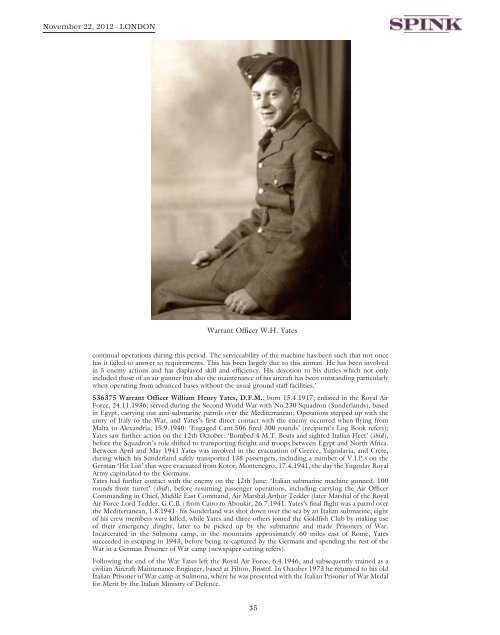orders, decorations, campaign medals and militaria - Spink
orders, decorations, campaign medals and militaria - Spink
orders, decorations, campaign medals and militaria - Spink
Create successful ePaper yourself
Turn your PDF publications into a flip-book with our unique Google optimized e-Paper software.
November 22, 2012 - LoNdoN<br />
Warrant Officer W.H. Yates<br />
continual operations during this period. The serviceability of the machine has been such that not once<br />
has it failed to answer to requirements. This has been largely due to this airman. He has been involved<br />
in 5 enemy actions <strong>and</strong> has displayed skill <strong>and</strong> efficiency. His devotion to his duties which not only<br />
included those of an air gunner but also the maintenance of his aircraft has been outst<strong>and</strong>ing particularly<br />
when operating from advanced bases without the usual ground staff facilities.’<br />
536375 Warrant Officer William Henry Yates, D.F.M., born 15.4.1917; enlisted in the Royal Air<br />
Force, 24.11.1936; served during the Second World War with No.230 Squadron (Sunderl<strong>and</strong>s), based<br />
in Egypt, carrying out anti-submarine patrols over the Mediterranean; Operations stepped up with the<br />
entry of Italy to the War, <strong>and</strong> Yates’s first direct contact with the enemy occurred when flying from<br />
Malta to Alex<strong>and</strong>ria, 15.9.1940: ‘Engaged Cant 506 fired 300 rounds’ (recipient’s Log Book refers);<br />
Yates saw further action on the 12th October: ‘Bombed 4 M.T. Boats <strong>and</strong> sighted Italian Fleet’ (ibid),<br />
before the Squadron’s role shifted to transporting freight <strong>and</strong> troops between Egypt <strong>and</strong> North Africa.<br />
Between April <strong>and</strong> May 1941 Yates was involved in the evacuation of Greece, Yugoslavia, <strong>and</strong> Crete,<br />
during which his Sunderl<strong>and</strong> safely transported 138 passengers, including a number of V.I.P.s on the<br />
German ‘Hit List’ that were evacuated from Kotor, Montenegro, 17.4.1941, the day the Yugoslav Royal<br />
Army capitulated to the Germans.<br />
Yates had further contact with the enemy on the 12th June: ‘Italian submarine machine gunned. 100<br />
rounds front turret’ (ibid), before resuming passenger operations, including carrying the Air Officer<br />
Comm<strong>and</strong>ing in Chief, Middle East Comm<strong>and</strong>, Air Marshal Arthur Tedder (later Marshal of the Royal<br />
Air Force Lord Tedder, G.C.B.) from Cairo to Aboukir, 26.7.1941. Yates’s final flight was a patrol over<br />
the Mediterranean, 1.8.1941- his Sunderl<strong>and</strong> was shot down over the sea by an Italian submarine; eight<br />
of his crew members were killed, while Yates <strong>and</strong> three others joined the Goldfish Club by making use<br />
of their emergency dinghy, later to be picked up by the submarine <strong>and</strong> made Prisoners of War.<br />
Incarcerated in the Sulmona camp, in the mountains approximately 60 miles east of Rome, Yates<br />
succeeded in escaping in 1943, before being re-captured by the Germans <strong>and</strong> spending the rest of the<br />
War in a German Prisoner of War camp (newspaper cutting refers).<br />
Following the end of the War Yates left the Royal Air Force, 6.4.1946, <strong>and</strong> subsequently trained as a<br />
civilian Aircraft Maintenance Engineer, based at Filton, Bristol. In October 1973 he returned to his old<br />
Italian Prisoner of War camp at Sulmona, where he was presented with the Italian Prisoner of War Medal<br />
for Merit by the Italian Ministry of Defence.<br />
35

















